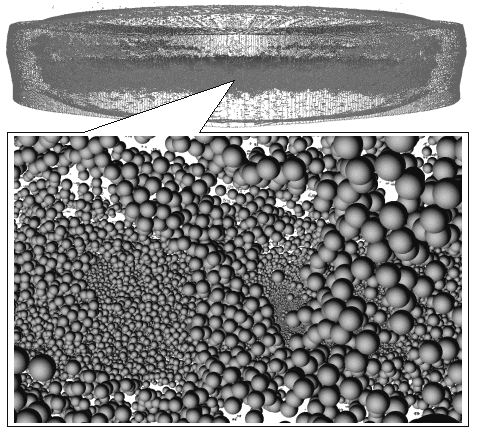Spall fracture in 3D single crystal materials
Plate impact experiments produce relatively simple deformation at very high strain rates, which makes these experiments to be essential tool for studying rapid fracture of materials. Detailed investigation of kinetic processes in the area of spall crack in 3D models requires large-scale computations on multiprocessor systems. Results of such computer experiment are presented below.
Fig.1. Comparison of the spall fracture in 2D and 3D
a) 2D specimen containing 100 thousands particles

b) 3D specimen containing 100 millions particles (cross-section)

Fig.1(a,b) shows comparison of the spall fracture experiments in 2D and 3D. In both cases this is a result of impact interaction between two plates. For the 2D case the whole specimen is shown, in 3D only the central cross-section of the cylindrical plate is presented. 100 thousands of particles were used in 2D simulation, while in 3D to obtain approximately the same scale 100 millions of particles were employed. Comparing 2D and 3D pictures one can find a lot of similarities, however several important differences connected with the structure of the spall crack and boundary effects can be noticed.
Fig.2. Spall crack formation

Fig.2 shows the whole 3D specimen and magnification of the fracture zone. For better visibility the specimen is made "transparent": only the boundary particles are shown in the figure. This produce underlining the original surfaces of the specimen and the new surfaces, developed during the spall crack formation. On the magnification of the spall zone one can see the vertical structures bridging the sides of the spall crack. The same structures are also visible on the cross-section of the specimen (Fig.1b).
For more information the following paper can be downloaded
- Krivtsov A.M., Volkovets I.B., Tkachev P.V., Tsaplin V.A. Application of particle dynamics method for description of rapid fracture of solids. Proceedings of "Mathematics, Mechanics and Informatics" conference dedicated to 10 anniversary of RFBR, accepted. (In Russian) (1139 Kb)
This work is done using the resources of the Joint Supercomputer Center.